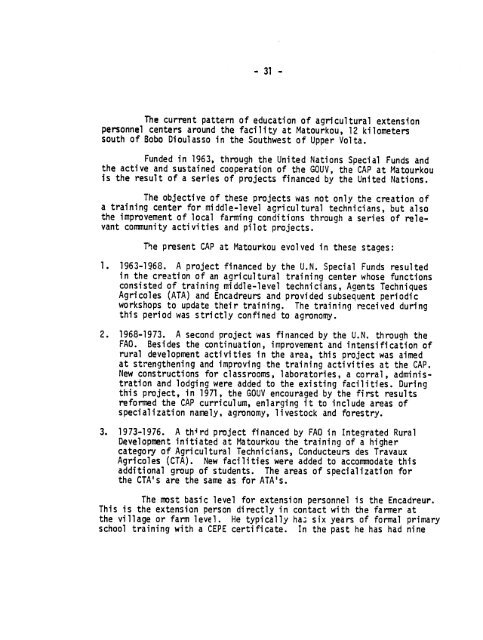Bi.,5 - (PDF, 101 mb) - USAID
Bi.,5 - (PDF, 101 mb) - USAID
Bi.,5 - (PDF, 101 mb) - USAID
- TAGS
- usaid
- pdf.usaid.gov
You also want an ePaper? Increase the reach of your titles
YUMPU automatically turns print PDFs into web optimized ePapers that Google loves.
- 31 -<br />
The current pattern of education of agricultural extension<br />
personnel centers around the facility at Matourkou, 12 kilometers<br />
south of Bobo Dioulasso in the Southwest of Upper Volta.<br />
Funded in 1963, through the United Nations Special Funds and<br />
the active and sustained cooperation of the GOUV, the CAP at Matourkou<br />
is the result of a series of projects financed by the United Nations.<br />
The objective of these projects was not only the creation of<br />
a training center for middle-level agricultural technicians, but also<br />
the improvement of local farming conditions through a series of relevant<br />
community activities and pilot projects.<br />
The present CAP at Matourkou evolved in these stages:<br />
1. 1963-1968. A project financed by the U.N. Special Funds resulted<br />
in the creation of an agricultural training center whose functions<br />
consisted of training middle-level technicians, Agents Techniques<br />
Agricoles (ATA) and Encadreurs and provided subsequent periodic<br />
workshops to update their training. The training received during<br />
this period was strictly confined to agronomy.<br />
2. 1968-1973. A second project was financed by the U.N. through the<br />
FAO. Besides the continuation, improvement and intensification of<br />
rural development activities in the area, this project was aimed<br />
at strengthening and improving the training activities at the CAP.<br />
New constructions for classrooms, laboratories, a corral, administration<br />
and lodging were added to the existing facilities. During<br />
this project, in 1971, the GOUV encouraged by the first results<br />
reformed the CAP curriculum, enlarging it to include areas of<br />
specialization namely, agronomy, livestock and forestry.<br />
3. 1973-1976. A third project financed by FAO in Integrated Rural<br />
Development initiated at Matourkou the training of a higher<br />
category of Agricultural Technicians, Conducteurs des Travaux<br />
Agricoles (CTA). New facilities were added to accommodate this<br />
additional group of students. The areas of specialization for<br />
the CTA's are the same as for ATA's.<br />
The most basic level for extension personnel is the Encadreur.<br />
This is the extension person directly in contact with the farmer at<br />
the village or farm level. He typically haz six years of formal primary<br />
school training with a CEPE certificate. In the past he has had nine

















